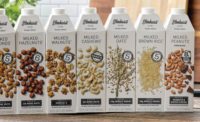2018 Predictions: Beverages
Hyper-personalized Beverages
Imbibe says beverage makers have many more new products to address consumer tastes, attitudes

Bubbly Meets Better for You: New sparkling waters offer taste, health options from carbonated soft drinks.
Health and wellness was one of the top trends driving new product innovation in 2017. Sugar reduction, functional health benefits and sustainability also had a strong influence on new food and beverage launches. Next year, 2018, won’t be drastically different. Instead, these movements will become more mature and specialized—and inspire beverages that are hyper-personalized to give consumers a range of options.
Here are some of the most pervasive beverage trends to look for in 2018.
Sparkling alternatives and nitrogen-infused expand into new beverages categories. Consumers are drinking fewer traditional carbonated soft drinks, and are turning to sparkling waters, juices and less traditional carbonated beverages as better-for-you alternatives. Although positioned as more “clean label,” these products represent a diverse offering and may or may not contain calories, sweetener, color or preservatives. Another up-and-coming textural component is nitrogen infusions, which add a creamy complexity and foamy headspace. Nitrogen infusions started in coffee and beer, but will expand into new arenas like tea, protein waters and juice.
Next-gen functional beverages with adaptogens, botanicals and protein. Consumers continue to demand more added value from their food and beverage products. Adaptogens and botanicals like ashwagandha and lavender generated significant buzz in 2017. REBBL Elixirs launched the first products that got consumers to recognize adaptogens last year, and opened the door for more brands to explore this class of ingredients. Curcumin, the active ingredient in turmeric, also will become more prevalent. It has antioxidant and anti-inflammatory properties, and will be found in beverages with turmeric or as an extract. And if you keep your finger on the pulse, you know protein shows no signs of slowing. In fact, expect more products like high-acid protein waters and protein fortification in hot applications like coffee, tea and hot chocolate.
Increased focus on sustainability. Companies are prioritizing the development of more sustainable business practices, and new brands and products are emerging based on the mission to reduce food waste. Anticipate more product launches featuring upcycled ingredients, and ingredients that would previously have been discarded. Misfit Juicery and Hungry Harvest use “ugly produce” (fruits and vegetables that would typically be disposed of because they don’t meet cosmetic standards). Cascara, another en vogue ingredient recently made popular by the Starbucks Cascara Latte, is made from the dried skins of the coffee cherry, and was previously discarded by farmers. Expect more upcycling in 2018.
Visual appeal for online sharing. Brands know that a strong social media presence can have a significant impact on a product’s overall success. The Starbucks Unicorn Frappuccino proved that visual appeal impacts consumer interest and the likelihood of a product going viral. Milkshakes are another beverage that have demonstrated a strong allure online. The hashtag #freakshakes has over 83,000 posts on Instagram. Instagram has become so influential to the food and beverage industry that the Culinary Institute of America is introducing two new electives in food photography and food styling in 2018.
Consumers are striving to be healthier, making more eco-friendly purchases, and documenting it all on social media. How they achieve these goals is based on lifestyle and personal values.
Product launches in 2018 will focus on fulfilling the individual needs of consumers, and offering consumers more choices than ever. The next iteration of products will give consumers a plethora of options and incorporate various demands such as a consumer’s diet (such as vegan, paleo, or allergen-free), functional needs (like stress relief, improved digestion or immunity) and personal values (like upcycled ingredients, cage free or compostable).
Originally appeared in the December, 2017 issue of Prepared Foods as Pour it On!
Looking for a reprint of this article?
From high-res PDFs to custom plaques, order your copy today!





